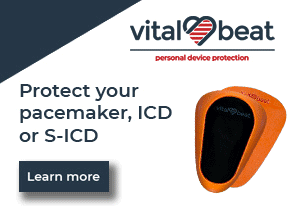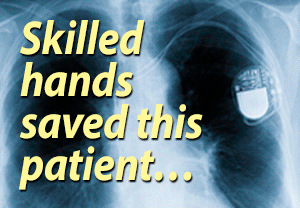 CRT-D question
CRT-D question
I was just reading some information about the difference between a CRT-D and a CRT-P or ICD and was interested in the treatment part of it in regards to the mild little shocks it gives to cause the heart to beat in both sides. I'm making this generic, but from what I understand, it's more than just regular pacemaker stuff like making your heart go faster when it needs to. If I read it right, this provides an extra bit of therapy that no other device does. It actually gives me some new hope that eventually it will help my low EF if I'm just patient. Apparently I don't have too much of an issue with my heart not speeding up when it needs to, unless I am not going fast enough. The time it takes to finally kick in is funny because by the time it starts "pacing" me, I've already sat down and no longer need my heart to go faster. LOL!
I was just wondering if someone had some better information about that therapy they could pass on to me. Thanks!
10 Comments
Gem... article link
by R2D2 - 2024-02-20 11:56:39
https://www.bostonscientific.com/en-US/patients-caregivers/device-support/crt/how-crt-works.html#:~:text=One%20is%20a%20special%20kind,defibrillator%20(CRT%2DD).
Here is the article I was referencing. You would think that my Medtronic manual would give me plenty of information, but it's so generic I had to go online.
Currently I am carefully living my life so as not to inadvertently cause a second shock. I'm keeping hydrated, eating carefully, and not doing any sort of extreme (for me) exercise. Since I fully believe my first shock was brought on by dehydration and electrolyte imbalance, I also believe that doing something sudden or unexpected like rapid changes in body movements or even losing my temper and flying off the handle... those things can cause abrupt changes in my heart rhythm, potentially causing a shock. My first shock experience taught me that I really can't afford more of those, my heart (and mind/body) took months to recover. I feel as though I'm walking a tight rope, but I am determined to get my life back.
This journey we are all on isn't for wimps. We are warriors.
Pleased you asked
by Penguin - 2024-02-20 12:53:36
Janene, thanks for asking for clarification on this. I really don't know any where near enough about CRT devices and have learned a lot from your posts already. Sometimes taking questions back to basics is helpful to many more people than you realise. I will read with interest.
CRT-D response
by Beni - 2024-02-20 12:55:59
Cardiac resynchronization therapy is a procedure to implant a device in the chest to make the heart's chambers squeeze (contract) in a more organized and efficient way. In my case, my two ventricles pumped out of sync.
Cardiac resynchronization therapy (CRT) uses a device called a biventricular pacemaker — also called a cardiac resynchronization device — that sends electrical signals to both lower chambers of the heart (right and left ventricles). The signals trigger the ventricles to synchronize their contractions in a more coordinated way, which improves the pumping of blood out of the heart. If you are like me (and you probably are) my right ventricle is paced at 99.91% as is my left ventricle. My right atrium, however, chugs along at less than 1% pacing.
The synchronization of the pumping of the two ventricles done by the device greatly reduces the stress on your heart, in general. So, yes, the CRT you have is pretty much doing most of the heavy lifting for your heart. Because the CRT improves the heart’s efficiency and increases blood flow, patients have reported alleviations of some heart failure symptoms, such as shortness of breath.
Cardiac resynchronization therapy with a defibrillator (CRT-D) may be recommended for people, such as myself, with heart failure who also have a risk of sudden cardiac death. It can detect dangerous heart rhythms and deliver a shock to reset the rhythm.
The device constantly monitors your heart. Not every arrythmia is a cause for concern. If it detects a rhythm that, according to the device's algorithms, is notable but not necessarily dangerous, it can also go into a special overdrive pacing mode which can “pace” the arrythmia you are experiencing back down again. My device has done this many times. I am completely unaware of it doing so and only find out it has done this when I am at the arrythmia clinic for the annual interrogation.
At my last interogation in January (25th), I learned it had monitored over 60 episodes of VT. Just in January. One was tracked for over 3 minutes. It "watched" but did not intiate a shock. My point is, generaly speaking, the shock feature really only kicks in when it is necessary; when more than monioring is needed.
It can take up to 12 months for any improvement to your EF to be noticed.
In the meantime, live your life in the present. Enjoy it. Don’t get hung up on numbers. Measure your progress by how you feel. Eat well, get good quality sleep and enough of it, find joy and love in the people and beauty in the things that surround you. Make a point of laughing. There is nothing particularly special about any of us. (When I see people around the world deal with absolutely harrowing adversity, I don't think I am brave. I think I am lucky.) You are the same as the rest of us. All of us have some issue with a heart condition. None of us know where the road we are on will take us. But don’t waste today. The present is the only absolute each of us has. Take full advantage of it.
All the best.
What a Great Post!
by Penguin - 2024-02-20 13:03:18
Thanks for that info and the inspiration Beni! Good advice and well said.
I've read..
by USMC-Pacer - 2024-02-20 14:16:49
..that the higher your CRT percentage, the better it works. Things that can affect your percentage are arrythmia such as PVCs, Afib, etc. Your clinic will want to get those under control to get a higher CRT effect. I originally misunderstood this as pacing percentage. When I first had the device implanted I was at 87% the other 13% was PVCs and AT. Now, i'm at 99.8% with .02% AT.. Hoping that improves to 100%. Does that mean it's working? I dunno, but it's the only thing on the report that I can see. I'll ask my clinic on my next in-clinic visit.
Does anyone else track those numbers?
Nope
by Beni - 2024-02-20 15:07:50
Greetings, USMC-Pacer
No, I don't track any numbers, really. I had to haul out my last report to quote the stats I did quote in my reply to R2D2.
My only question to the techs during the interogation is: " Everything looking good?" If the answer is yes, then I'm outta there. I have "stuff" to do.
The EP who did my surgery cautioned me not to get too wrapped up in "the numbers". He told me to focus on how I felt. He said"you are the in-house expert on you and how you feel. Tell me how you feel and I will take it from there."
At first, I thought this was a bit of a "control the info" thing. But, afterwards, I thought about what he said. After all, I have yet to quiz the pilot of the Airbus A-380 I might be travelling on about what flight data I should know about or have asked him (it's usually a "him") what the reading on that dial or gauge means, either before take-off or during the flight. And, yes, he, too, has my life in his hands. Might it help me to know? To feel more at ease? Probably not. Way above my pay grade. The same with the EP's area of expertise.
(Besides, the number of variables, besides "the numbers", the EP has to take into account when arriving at any conclusion about my health status vis a vis the device, is simply mind-boggling. Interpretation of that much data makes me feel slightly queasy.)
I look at this way. I will be 70 years old this April. That number, as it applies to me, still astonishes me. I mean, who knew I could get "this old" - which I might add, doesn't seem old at all now that I am here. My 25 year-old-self never entertained such an idea. ;) But here I am. And the hard drive that is my memory is getting crowded. So, what little space it has left, I want to fill with lovely sights and sounds. With wonderous experiences. With great books. Hobbies I love. My dog. My husband (in that order). With warm and lingering memories. With laughter and time with good friends and loved ones. With a much better golf swing and score. (That last part is proving to be challenging.) And so much more. So, I am happy to let someone else "fly the plane". I am too busy livin' life.
I just hope, dear USMC-Pacer, that you feel well - really well. And your interest in "the numbers" is just that - an "interest", not a way of defining your health. Because, when I read your posts, my friend - and I do read them - you strike me a dynamic individual with a real zest for life. That positive outlook on life is your real power - even if your device isn't firing at 100%. You are.
Take care of yourself, sir.
USMC-Pacer
by Gemita - 2024-02-20 15:38:23
You are absolutely correct. A high percentage of biventricular pacing is essential for the delivery of optimal CRT. In fact, we don't want to try to avoid ventricular pacing with CRT as we might with RV pacing. This would defeat the whole purpose of synchronised ventricular pacing. It seems that effective CRT present for more than 98.4% of the time is associated with better clinical outcomes, so the higher the percentage, obviously the better.
Of course not everyone will respond equally to CRT, depending on their other health conditions, meds, arrhythmias.
I do follow my numbers, at least Mode Switches and Atrial/Ventricular High Rate Episodes to monitor my AF, NSVT, so that I will know when I need to take further action to control these. Otherwise, no
Beni & Gemita
by USMC-Pacer - 2024-02-20 16:25:32
I do feel incredible compared to last year so that means improvement to me. I wouldn't say I get hung up on the numbers, I just try to understand the basics <- very basic in this case as I would bet it's more complicated than the jet example. The only number that I'm hung up on, and I'm doing my best to forget about it is my HR. Especially during exercise! Trying to avoid that MTR like my life depends on it. BUT, I'm thankful now that it doesn't hit me anymore, at not putting me into a 2:1, so now I'm trying to ignore, well not ignore, but passively move on from that "addiction" to that number. Someone else here posted about that too.. stop worrying about the number (in my case, HR) and go by how you feel! That is great advice! My next numbers and testing come up in April.. Lets see how that goes. By the way I feel, I'm sure there is improvements! To connect this to the above and not hyjack this :) I think lots of us here are working toward improving that one number = EF
We are basically schooled about those numbers...
by R2D2 - 2024-02-20 21:51:01
From the time we are diagnosed with heart failure, the doctor gives us numbers. I remember my doc said ejection fraction, something about 30-35 at best.... yadda, yadda... then it's not like an actual percentage, yadda, yadda... something about LBBB, and a couple other things in passing and what I kept with me was 30-35. I had NO idea what it meant, or would mean later, but from the way he explained it, I had nothing to worry about; BUT I should probably get a pacemaker. That was 9 years ago.
Now I KNOW what most of the stuff means, aside from when some of you start spewing all of those other numbers having to do with how your pacemaker is pacing, and where, and etc. I'm sure I could get a print out of my latest visit with the technicians, but in all honesty, it's just something else I would worry about. I'll keep it simple (reletively) and just concern myself with feeling better. Clearly the other stuff I'm waiting on will happen when it wants to.
You know you're wired when...
You take technology to heart.
Member Quotes
At age 20, I will be getting a pacemaker in few weeks along with an SA node ablation. This opportunity may change a five year prognosis into a normal life span! I look forward to being a little old lady with a wicked cane!




You are a good student and you are sounding so positive
by Gemita - 2024-02-20 04:54:22
Janene, it would be extremely helpful and perhaps widen this discussion, if you could kindly provide details of the link(s) you are referring too, so that we will know how best to answer your post?
Since Cardiac Resynchronization Therapy (CRT) is usually required when we have an EF (ejection fraction) less than 35%, when the chances of a dangerous arrhythmia are more likely to occur, it makes some sense, at least to me, to have a CRT-Defibrillator implanted instead of a CRT-Pacemaker, particularly if the cause for the heart failure cannot be reversed.
From my understanding of your question, the Defibrillator part of any CRT device, will have far more in the way of anti tachycardia pacing therapies and other useful algorithms to treat significant arrhythmias than would say a CRT Pacemaker device without the benefit of a defibrillator. You clearly have the best of both worlds, a CRT device that keeps both ventricles in synchrony as well as having a defibrillator to stop a dangerous arrhythmia. Your CRT-D device will provide a full range of anti tachycardia pacing therapies and have algorithms that would not be available in a CRT-P device.
Of course you are in extremely safe hands. You have got the best chance of full protection, now we just have to find a way of stopping the device from firing. As your EF improves, you should start to notice fewer arrhythmias which should = fewer potential shocks.
I would consult your specific CRT-D manual to find what pacing therapies are available for your particular device. You will find a wealth of information in your manual and as you learn what this all means, you will benefit even more.